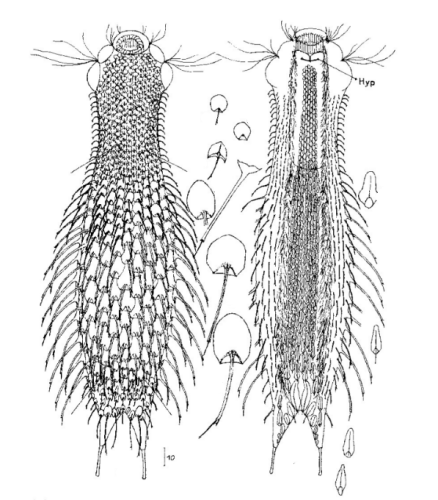Chaetonotus (C. ) hoanicus

200 µm - 260 µm
Width:
45 µm - 55 µm
Width of the head ( five-lobed ):
35 µm
µm
Length of the furca:
35 µm - 38 µm
Adhessive tubes:
75% of furca
Pharyx ( cylindrical, terminal slightly swollen ):
70 µm - 80 µm
Diameter of the mouth ( round ):
11 µm
Dorsal scales:
Head: 18-19 rows; body 10-11 rows with a total of 33-40 thin, strongly overlapping heptagonal to rectangular scales (19µm x 9µm), each bearing a spine (2µm - 40µm) with a secondary tip; short spiny field at the rear end
Ventral scales:
ventral intermediate field with two curved, keeled terminal plates;8-9 rows of keel scales (partly spiny); oval, smooth scales in the pharynx region
Oecology:
Moor; Sumpfgewässer
Similar species:
variable species; similar to C. (C. ) similis (can be diverged by scale shape and change in spine length); C. (C. ) maximus (no secondary spikes); C. (C. ) heterospinosus (more rounded); C. (C. ) pilaga (scale form and terminal spines)
Particularities:
Distinct system of pharyngeal veins
Fundorte:
Chaetonotus hoanicus is a very rare gastrotrich that has so far only been observed by Schwank. I would therefore like to describe it in more detail.
The main characteristic of Ch. hoanicus is the abrupt transition from an unspined (or shortly spined) head area to a relatively long spined back:

Ch. hoanicus: Change of the dorsal spination
The scaling of the neck/head area consists of almost round, strongly overlapping scales with only an extremely short - often only perceptible - spine:

Ch. hoanicus: Change in the dorsal scales on the neck
With an abrupt transition to long spiny scales the area of the trunk scales is clearly separated. The trunk scales are relatively large, roughly pentagonal and have a large cut-out at the rear end. Spines approx. 15-20 µm long arise from its tip, which are provided with a secondary tip distally.

Ch. hoanicus: Modification of the dorsal trunk spination
In the anal region there is a short spined field. Some conspicuous, longer spines protrude into the toe cutout.

Ch. hoanicus: Change in the dorsal spination of the anal region
The exact scale shape only becomes clear when it is possible to detach scales:

Ch. hoanicus: Individual dorsal scales from the dorsal region
The particularly pronounced tuning fork-shaped structure of the pharyngeal surface, which connects the oral cavity with the glands in the pharyngeal wall (see Pharynx), is conspicuous:

Ch. hoanicus: Structure on pharyngeal surface
If one films a living specimen of Ch. hoanicus with the focus on these “veins”, a clear flow within these structures becomes visible, indicating a gland-like function:

Ch. hoanicus: Movie about flow in the “pharyngeal veins” ( https://www.youtube.com/watch?v=tIhu4Xhe14U )